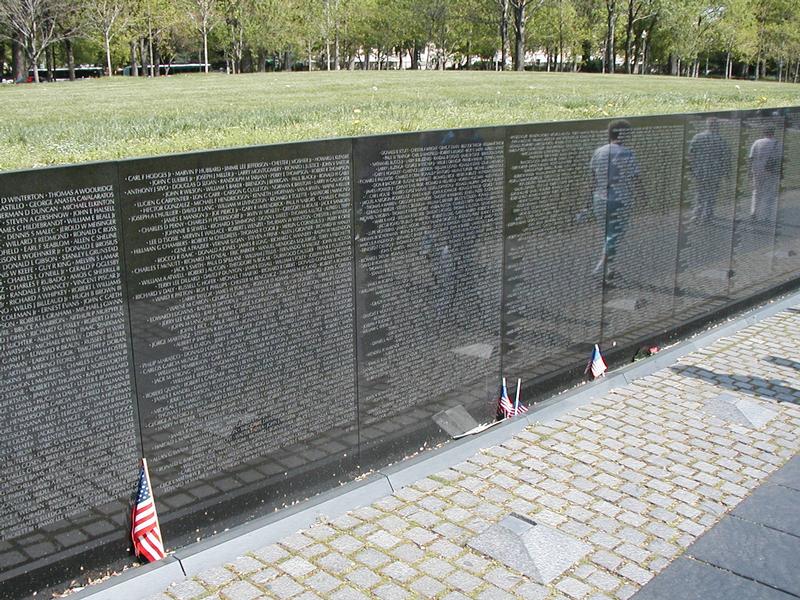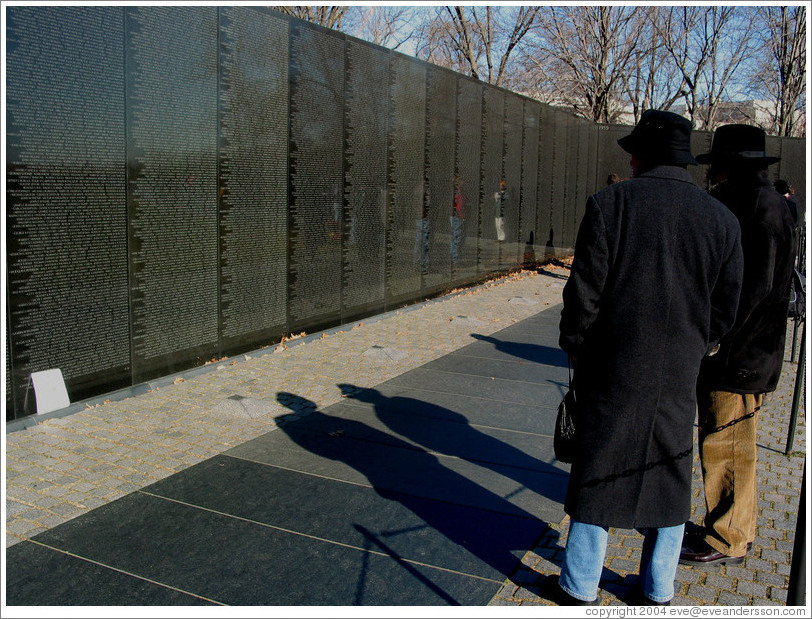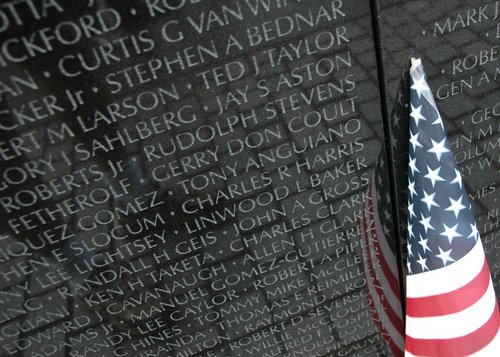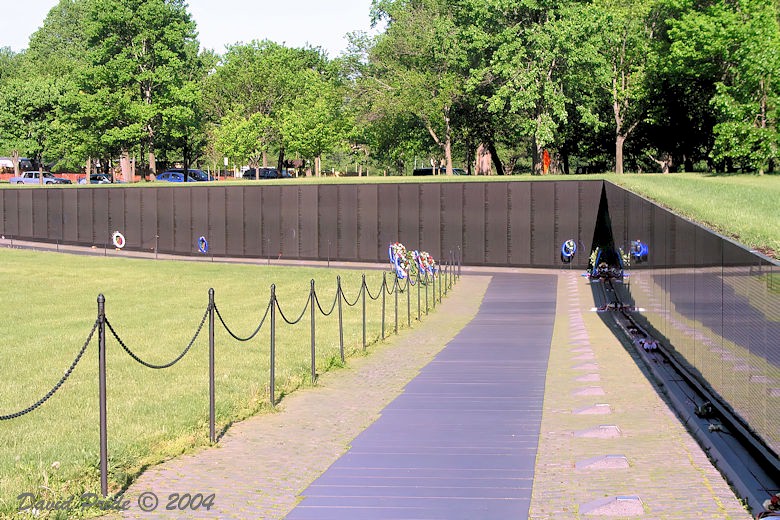
心灵的伤痕——越战纪念碑 zt
幼河
来美国十余年没去过首都华盛顿DC。我确实是一个就喜欢田园风光,讨厌都市喧闹的人,但这不是不去参观DC的主要原因。我嘛…就是“懒得去”,虽然已经移民美国,毕竟不是“老美”心态。潜意识里总是“那是人家的首都”。有了这种感觉,就是住得离DC200英里也不肯驱车走一趟,直到妻子、女儿再三要求,这才在一个阳光明媚的春天的早晨前往“报到”。其实我也并非完全“懒得去”,参观一下越战纪念碑也算个心愿。
越战纪念碑建于美国的1980年代,人们常常管它叫“哭墙”。越战老兵凭吊战友,亲属悼念阵亡的亲人,纪念碑下永远有说不完的伤感故事,年复一年。这碑到底是什么样的呢?
远远见到越战纪念碑时,因为距离远,竟以为碑面是色调暗淡的湖水。走近观全景,不禁折服其设计的构思,当年耶鲁大学二十岁的华裔女孩儿,MAYA LIN的确为美国献上了杰作。这一设计是这样普通,却又极具艺术效果。
光亮的深灰色大理石碑面上刻着58196名越战阵亡美军官兵的名字,这是人人皆知的。但不知你注意了没有,这一行行密密麻麻的名字是按死者阵亡时间顺序排列的。在长长的碑的中间刻着1959和1975两个大大的阿拉伯数字,表示战争延续的年代。十七个年头!这五万八千多个名字给人极其强烈的视觉效果,心灵受到震撼。其实这一构思并非MAYA LIN独创。中国南京中山陵附近有个灵谷寺,当年是为纪念北伐战争阵亡将士建造的。灵谷寺前有个无梁殿,里面许多粗大的石柱和四周墙壁上刻满阵亡将士的名字,有将近十万!那年我第一次看到这些名字,手抚摸着,思绪万千,那颗中国心在激动。如今见到这整整一墙的名字,我能体会一个富有民族感情的美国人的心情。
照我的理解,越战纪念碑是“挖”出来的。在林肯纪念堂正面的左边是纪念碑的位置。那里原本是片平平的的草地,建碑时是把草地挖下去,挖出直上直下的那面铺上刻名字的碑面,剩下三个方向都是缓缓的漫坡。碑面正对着的方向重新铺上草地,东、西两个方向当然修成碑前的走道。因为是缓坡,没有台阶,无论你从东边走,还是从西边走,都是慢慢地延着碑面走到坡下面,然后在走上来。也就是说,当你走下缓坡时,碑面开始的部份非常之“矮”,随着往缓坡下走,碑面渐渐“高”起来,当你走到最下面,碑面“高”有大约三米左右。顺着碑面再往缓坡上走,碑面又渐渐“矮”下去,走到最上边,碑面就没有了。
碑面不是一道笔直的平面,而是两个,在接近碑的中间部份,两个平面连接起来形成很大的钝角。你也可以把碑面看成两个连接在一起的锐角直角三角形。站在深灰色调的碑下,你隐隐地有被“哭墙”环抱的感觉。这样就更增加了悲情的气氛。独具匠心。
我之所以这样罗哩罗嗦地说越战纪念碑的形状,是希望你有个概念:这“哭墙”是个“地下建筑”,平平的草地被铲下去修建的。嗯,为什么不可以把这“哭墙”理解成心灵的伤痕呢?心被狠狠地砍了一刀,伤口可以愈合,不再涌出鲜血,但伤痕,那永久的伤痕不会消失,不会平复。看看那五万八千多个名字吧。
春光明媚,阳光灿烂。长长的“哭墙”下放着很多鲜花、相片、小小美国国旗、各种各样的纪念品等等,甚至还有玩具熊。一个穿着迷彩服的,身体已经非常虚弱的老军人坐在轮椅上,由亲属推到碑前,在人们搀扶下,他跪在熟悉的名字边上,用手轻轻地一遍遍抚摸;一个年轻姑娘欠起脚,用笔和纸在拓一个名字,她皱着眉毛,神情极其专注;一个小伙子蹲在地上,指着一个名字激动地向边上的人诉说着什么;一个老妇人久久地摸着墙上的名字,闭着的眼睛里流着眼泪……
多少年,多少年……
Deep Memories
On October 31, 2001, The Vietnam Veterans Memorial Fund announced plans to build an underground visitor center near its dramatic, black granite memorial wall on the National Mall in Washington DC. This is the latest in a series of subsurface visitor centers designed to be nearly invisible in their support of military memorials. Some have already been built, some are scheduled for construction, and some never got off the ground.
Built Examples
Vietnam Veterans National Memorial
One of the earliest examples is at the Vietnam Veterans National Memorial near Angel Fire, New Mexico. Built in 1971, this memorial consists of an architecturally stunning, non-denominational chapel that emerges from the earth and reaches skyward with graceful, wing-like walls. In 1982, detailed planning began on a long-overdue and much-needed visitor center. The challenge was how to add a new building near the chapel without spoiling the almost-mystical synergy of the mountain scenery and the unique memorial structure. The solution was found underground.
The visitor center, completed in 1985, is barely visible in a gently sloping hillside below the chapel. A small, square skylight punctuates the grassy field, hinting at something beneath the surface. On the hill's front slope, two concrete-framed portals establish the building's facade. A paved path leads into one of them, where visitors can enter the center. The other portal is less visible; shielded by trees and isolated by a grassy slope, it encloses a private courtyard for the living quarters of Dr. Victor Westphall, the memorial's developer and operator.
Women in Military Service for America Memorial
The Women in Military Service for America Memorial, built at Arlington National Cemetery, across the Potomac River from Washington, DC, in 1997, is recessed into a hillside behind an ornate retaining wall that was built in 1932. Known as the Hemicycle, the historic granite wall has long been a symbolic gateway to the cemetery. Built in a neo-classical style, it is a 30-foot tall, 200-foot-wide semicircle. Cleaned and repaired, it has been subtly modified to create entryways to the memorial and visitor center that has been created behind it. Entering through the wall, visitors walk into a 37,000-square-foot building. The front room, a long exhibit gallery, curves around the inside face of the Hemicycle. Its roof is an integral part of the memorial, serving as a quiet patio where visitors can look out over the cemetery's rows of white grave markers and also read inions on a series of glass panels that serve as skylights for the building below. At the rear of the narrow patio, the rolling hillside terrain rises to the rooftop level, covering the portions of the building that contain additional exhibits, a gift shop, a 200-seat theater, and administrative spaces.
Proposed Examples
Vietnam Veterans Memorial
The Vietnam Veterans Memorial consists of a 10-foot-high polished, black granite wall engraved with the names of more than 58,000 service people killed during that war. But it does not rise above the National Mall, it recedes into it. To keep the new 8,000-square-foot visitor center from detracting from the powerful simplicity and low profile of the wall, the center will be hidden underground. The only visible portion will be a small, glass and metal entrance kiosk providing sheltered access to elevators and escalators that lead down to the exhibit spaces and a 50-seat theater.
National Law Enforcement Officers Museum
The National Law Enforcement Officers Memorial was built in 1991 in the area of Washington, DC, known as Judiciary Square. It is somewhat reminiscent of the Vietnam Veterans Memorial in that it consists of marble walls on which are inscribed the names of local, state, and national law enforcement officers who have lost their lives in the line of duty. The sponsors of the memorial are planning to add a 70,000-square-foot museum to provide information on law enforcement history, encourage public safety, and display some of the personal mementoes that have been left at the walls in remembrance of the honorees. In part to avoid intruding on the solemn vista, and in part to fit into a heavily-developed urban environment, a new museum will be located primarily underground. The paved parking lot now occupying the site will become a landscaped garden with a small aboveground portion providing entrance to the museum.
Reconsidered Examples
Air Force Memorial
A proposed Air Force Memorial near Arlington National Cemetery will consist of a 50-foot-tall star-shaped sculpture resting on a granite platform. The original plan included a two-story reception and exhibition hall that would nestle unobtrusively under the sculpture and the ground. Ultimately, however, the memorial foundation's board decided to omit the underground portion because of short-term and long-range budgetary constraints.
National World War II Memorial
The initial design for the World War II Memorial on the National Mall in Washington, DC, aroused widespread opposition. Not only did it bulge out beyond the tree-lined perimeter of the grassy mall, but it rose 50 feet into the air, "hiding" an associated interpretive center obtrusively within massive earthen embankments. Amid the onslaught of vehement protests, the memorial's sponsors asked its architect to redesign it to fit more appropriately within the treasured mall. The revised design, narrower and more transparent, is recessed 7 feet below street level but contains no underground enclosures.
A Sub-Foot Note
Aside from the compelling need to protect views of natural scenery and elegant monuments, there is another consideration that makes underground buildings appropriate at war memorials. Perhaps it is most dramatically presented by the Aschrott Brunnen negative-form monument in Kassel, Germany. It was built in 1987 to commemorate a 40-foot-high pyramid-shaped fountain that was destroyed by the Nazis in 1939 because it had been designed by a Jewish artist. To dramatize the 48-year absence of the fountain, artist Horst Hoheisel designed the modern memorial as an inverted image of the original that penetrates down through the plaza rather than rising above it. Glass blocks cover the upturned base of the structure, allowing visitors to see how the hollow white obelisk extends into the earth. Water flows through ground-level channels and runs down over the anti-fountain, creating the sound of rushing water without visible spouts or sprays.


Vietnam Veterans Memorial Wall:
Offerings of Love and Healing

Vietnam Veterans Memorial:
Three Servicemen Statue

Vietnam Veterans Memorial
Written by Scott Messmore
The Vietnam War was one of the most divisive issues America had faced since the Civil War. When it came time to honor the men and women who lost there lives in Southeast Asia, the selection of a design also proved to be a contentious issue. Congress authorized a plan to create a Vietnam Veterans Memorial that would honor the nation's fallen warriors without commenting on the reasons for or against the war. Examining hundreds of prospective designs, Yale University student Maya Ying Lin was given the assignment for her black marble wall with the name of each serviceman who died during the Vietnam War. Lin's design was a black granite angled wall with the names of all the veterans who died in Vietnam. Many historical and veterans groups protested the unorthodox design and wanted to add a more traditional statue and an American Flag. Proponents of Lin's design in turn opposed emplacing any sculptures.
The Wall
Commonly referred to as "The Wall", the Vietnam Memorial was built in 1982 near the Lincoln Memorial. In response to protests, a 50- foot American Flag and a statue of three serviceman created by Frederick Hart was added to the Vietnam Memorial in 1984. To honor female Vietnam veterans, artist Glenna Goodacre's statue of field nurses was emplaced at the site in 1993. Many family members and friends of fallen servicemen bring momentos, combat medals, old fatigues, letters from home or childhood toys to leave at the Wall. Flowers are often left at the Wall and active duty military personnel have been reenlisted at the memorial. Each section of the Wall is nearly 248 feet long and made of black granite with 57,939 names inscribed in one-inch tall lettering. More names have been added to the Wall since 1982 as the remains of servicemen missing in action are identified and returned to their families in the United States for proper burial. One end of the Wall points toward the Washington Monument and the other points at the Lincoln Memorial. One-hundred-and-forty concrete pylons were sunk 35 feet into the ground to support the Wall. Each side of the Wall rises from the ground to a height of 10 feet in the center.
Finding Names on The Wall
The names of fallen servicemen are listed in order by the year they were killed in action. For visitors who want to locate the name of a family member or friend on the Wall, the National Park Service advises bringing the name, birthdate, service number, date of death and the state or city of original military enlistment. A Park Service Ranger will be on hand at the memorial to assist family and friends. At the Wall, copies of the Vietnam Veterans Memorial Directory of Names are positioned at each end of the Wall. For on-line help in finding a name, visit www.vvmf.org for the Vietnam Veterans Memorial Fund web site.
Hours of Operation and Location
The Vietnam Memorial is open each day, except for Christmas Day from 8 a.m. to 11:45 p.m. The Vietnam Veterans Memorial is located on the National Mall near the Lincoln Memorial. Since the structure is below ground level, visitors won't be able to see it until upon it. Bikes and inline skates are not permitted along the two walls of the Vietnam Veterans Memorial. As in many major cities, parking can be a nightmare and Washington D.C. is no exception. Visitors to the National Mall and Vietnam Veterans Memorial can ride several different Metro routes. The Smithsonian Institution Metro station will place visitors right on the National Mall. Visitors can also park at the Washington Monument and the Jefferson Memorial.




Vietnam Veterans Memorial










 选择“Disable on www.wenxuecity.com”
选择“Disable on www.wenxuecity.com”
 选择“don't run on pages on this domain”
选择“don't run on pages on this domain”

